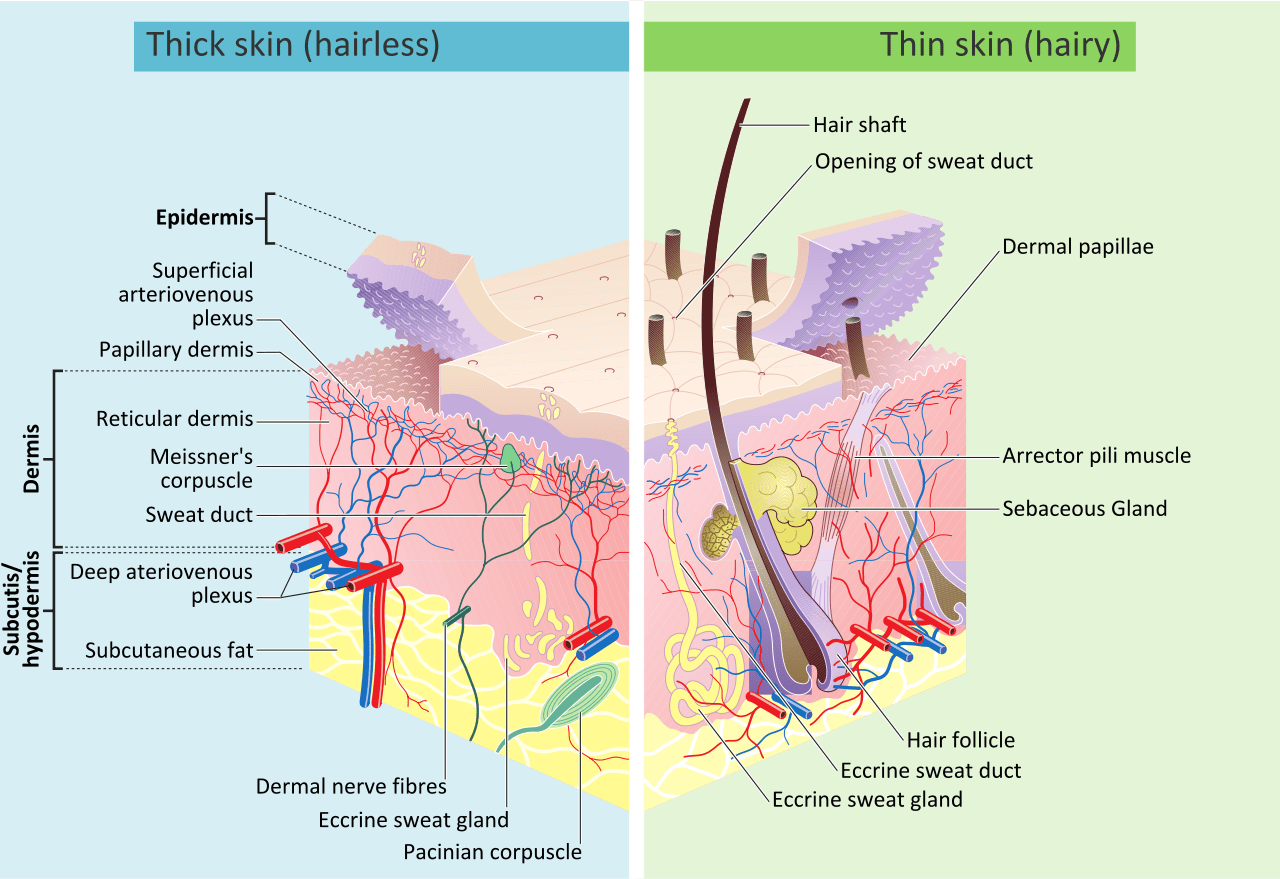The skin is the largest organ. It comprises three layers: epidermis, dermis, and subcutaneous tissue.
It is made of stratified squamous epithelium and is composed mainly of keratinocytes and dendritic cells. It is renewed continuously with new cells being formed from basal cells. The epidermis is arranged in five layers, from deepest to superficial, as follows:
It is formed of cuboidal to columnar mitotically active stem cells called basal cells, arranged in a single layer that constantly produces keratinocytes. They adhere to each other by desmosomes and to the basement membrane by hemidesmosomes. The basal cells have dark-staining elongated nuclei. This layer also contains melanocytes which are clear cells with long, branching cytoplasmic projections. Melanin produced by the melanocytes is taken up by adjacent keratinocytes by phagocytosis. Melanosome number is the same among the sexes and races. Differences in skin color depend on how much melanin is produced, the size of the melanosomes (melanin-containing vesicles), and their level of aggregation, forming aggregates in white-skinned persons and found in a more dispersed form in dark-skinned individuals. This layer also has Merkel cells which are mechanoreceptors for light touch and are numerous in fingertips.
It is also called the squamous cell layer or prickle cell layer due to the presence of spine-like cytoplasmic projections in cells. It is made of squamous cells, the cells becoming progressively flatter and larger towards the top layers. They are bound together by desmosomes and gap junctions. These cells are metabolically very active and give the skin tensile strength. This layer also has Langerhans cells, which are dendritic cells of the skin. They function in antigen presentation. They are identified by characteristic tennis racket-shaped intracytoplasmic Birbeck granules.

So-called as they contain diamond-shaped cells with basophilic keratohyalin granules. These granules contain keratin precursors. This layer is thick in palms and soles, while it is thin in psoriasis. This layer is rich in lysosomal enzymes.
This layer is made of dead keratinocytes and is seen in areas with thick skin like palms and soles. It is a clear layer consisting of eleidin which is a breakdown product of keratohyalin.
It is the outermost layer of the skin. It is made of dead keratinocytes called horny cells or corneocytes. It is rich in keratin and has a role as an environmental barrier, preventing water loss and providing the first line of defense against immunogens. It varies in thickness depending on the area of the body. Remember that in thicker skin, like palms and soles, the stratum corneum and lucidum will be thicker.
The basal lamina or basal membrane separates the epidermis from the dermis. It has type IV collagen.

The dermis provides the bulk of the skin, is present under the epidermis, and makes the skin supple, elastic, and provides tensile strength. It atrophies with age leading to thinning of the skin. Estrogen helps maintain the suppleness of the dermis. It has an upper papillary layer composed of loose connective tissue and a deeper, thicker reticular layer composed of collagen. Fibroblasts produce and secrete procollagen in the dermis. Dermis has primarily type I collagen and some type III collagen. It also has few elastic fibres. It contains sweat glands, hair follicles, blood vessels, sensory neurons, and muscles. Mast cells are present in the dermis.
This layer present under the dermis has subcutaneous fascia and fat.
The skin has two plexuses - one between the papillary and reticular layers of the dermis, called subpapillary or superficial plexus, and the other between the dermis and subcutaneous tissue. The superficial plexus is important for thermoregulation, vasodilation and heat loss occurs when body temperature is high and vasoconstriction occurs on exposure to cold conditions. Changes in blood flow and sweating are mechanisms used to regulate body temperature. It mainly involves sympathetic innervation to the cutaneous blood vessels, that means, sympathetic stimulation causes vasoconstriction and conserving body heat while sympathetic inhibition causes vasodilation and loss of body heat.
These include sweat and sebaceous glands, hair, and nails.
They include apocrine, eccrine, and apoeccrine sweat glands. Apocrine glands are responsible for body odor, are present in the axillae and perineum, and open into pilosebaceous follicles. They become active just before puberty. Eccrine sweat glands are involved in thermoregulation. They are most abundant on the soles. Its duct opens on the surface of the skin. Eccrine glands have clear, secretory cells, darker mucoidal cells, and contractile myoepithelial cells. Interestingly, postganglionic sympathetic fibres innervating eccrine glands for thermoregulation use acetylcholine as a neurotransmitter while postganglionic sympathetics causing emotional sweating release norepinephrine as a neurotransmitter. Apoeccrine glands are like apocrine glands but they open onto the surface of the skin. They have a very high rate of secretion and are associated with hyperhidrosis.
They secrete oily sebum. They are found on most areas of the skin except palms and soles and are abundant on the face and scalp. Some open into hair follicles, while few open directly on the skin surface. They are involved in the development of acne.
Sign up for free to take 17 quiz questions on this topic